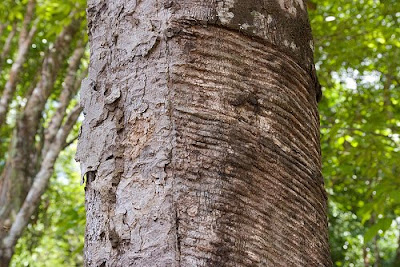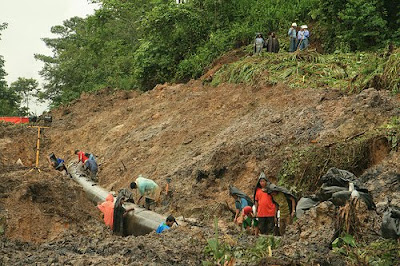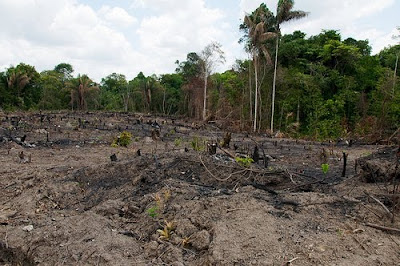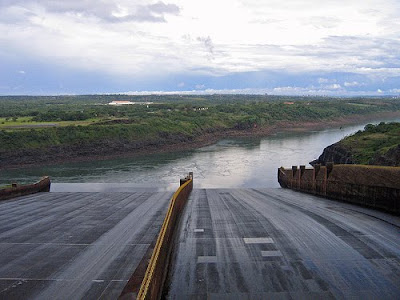Last week during his address at the International Forum on Sustainability in Manaus, Mr. Cameron expressed his concern about the project saying: "For people living along the river, as they have for millennia, the dam will end their way of life. I implore the Brazilian government, and President Lula, to reconsider this project."
Photo courtesy of Denise Gramelick/Flickr
Wednesday, March 31, 2010
Brazil Using Condoms to Protect Rainforest
Brazil has unrolled an ambitious plan to preserve vast areas of the Amazon rainforest by tapping its rubber trees to make sustainable condoms.
Photo courtesy of NWF/Flickr
Photo courtesy of NWF/Flickr
Tuesday, March 30, 2010
Peruvian Amazon trees a niche market for carbon trading
Trees grow faster in the Amazon rainforest -- the lungs of the planet -- than anywhere else in the world, and can reach between six to 12 metres (18 to 36 feet) in just one year.
Photo courtesy of Jeffrey Yamaguchi/Flickr
Photo courtesy of Jeffrey Yamaguchi/Flickr
Nuns face guns, impunity in trying to save Amazon
The main cause of deforestation, the government says, are ranchers who illegally clear jungle to graze cattle and grow soy — often using threats and violence to remove the poor farmers eking a living there.
Photo courtesy of Charles Thomas/Flickr
Photo courtesy of Charles Thomas/Flickr
Sunday, March 28, 2010
James Cameron asks Lula to reconsider the project of Belo Monte
In Manaus, Cameron said that the environmental and social impacts of the plant need to be prioritized by the Brazilian government. "I beg to President Lula to reconsider," said Cameron.
Please note: This article is in Portuguese.
Photo courtesy of Kathy Willens/AP
Please note: This article is in Portuguese.
Photo courtesy of Kathy Willens/AP
Saturday, March 27, 2010
"I do not damage the forest for a movie," says Cameron
James Cameron explains why you do not want to shoot in the Amazon rainforest.
Please note: This article is in Portuguese.
Photo courtesy of Kathy Willens/AP
Please note: This article is in Portuguese.
Photo courtesy of Kathy Willens/AP
Thursday, March 25, 2010
Planned oil pipeline in Peru may pose threat to Amazon tribes
The pipeline is being built to transport an estimated three hundred million barrels of oil from the depths of the northern Peruvian Amazon. The company makes no mention of the tribes in its report detailing the potential social and environmental impacts of the pipeline, despite the fact they could be decimated by contact with Perenco’s workers.
Photo courtesy of powless/Flickr
Photo courtesy of powless/Flickr
Forest loss slows, as China plants and Brazil preserves
The world's net rate of forest loss has slowed markedly in the last decade, with less logging in the Amazon and China planting trees on a grand scale.
Photo courtesy of David Bryngelsson/Flickr
Photo courtesy of David Bryngelsson/Flickr
Labels :
Africa,
Biodiversity,
Brazil,
China,
Deforestation,
Eduardo Rojas,
FAO,
Indonesia,
Logging,
South America,
UN
Wednesday, March 24, 2010
Global deforestation slowed over last decade - UN
Indonesia sharply reduced the speed of its deforestation to 0.5 million hectares a year between 2000 and 2010, versus 1.9 million a year during the previous decade. Brazil lowered its own figure to 2.6 million from 2.9 million hectares.
Photo courtesy of Damon Winter/NY Times
Photo courtesy of Damon Winter/NY Times
Labels :
Asia,
Brazil,
China,
CO2,
Costa Rica,
Deforestation,
Eduardo Rojas,
FAO,
India,
Indonesia,
South America,
UN
Friday, March 19, 2010
Auction date set for Belo Monte hydro project in Brazil
An auction to sell the rights to build and operate the Belo Monte hydroelectric project in Brazil's Amazon will take place on April 20, the Mines and Energy Ministry reported.
Photo courtesy of stephenk1977/Flickr
Photo courtesy of stephenk1977/Flickr
Thursday, March 18, 2010
Wednesday, March 17, 2010
Forest protected areas important for slowing climate change
The authors highlight analyses showing that since 2002, deforestation in the Brazilian Amazon has been 7 to 11 times lower inside of indigenous lands and other protected areas than elsewhere.
Photo courtesy of apoloniox70/Flickr
Photo courtesy of apoloniox70/Flickr
Brazil tackles deforestation of its savanna
Officials will use satellites to monitor the ecosystem known as the Cerrado, Minister Carlos Minc said, while imposing fines and offering incentives to encourage preservation of what has become Brazil's main grain-producing area.
Photo courtesy of PSantaRosa/Flickr
Photo courtesy of PSantaRosa/Flickr
Tuesday, March 16, 2010
Protected species in the Amazon's Cristalino state park (15 pictures)
The park, in Mato Grosso, is one of the most biodiverse reserves in the region. But lack of management means it remains under serious threat from fire and illegal logging. Little is known about the botanical diversity of the region, and regional capacity for research is limited.
Photo courtesy of E Bowen-Jones/FFI
Photo courtesy of E Bowen-Jones/FFI
Monday, March 15, 2010
Amazon confusion: new research shows forest is resilient to drought, but is this the whole picture?
Given the differing opinions, more research may be needed before consensus can be reached on how the Amazon will react to climate change, especially in light of other threats such as deforestation.
Photo courtesy of sibauch/Flickr
Photo courtesy of sibauch/Flickr
Sunday, March 14, 2010
The majestic rivers of Amazonia
The Juruena River is one of Brazil's most stunning water courses, once running through pristine landscapes and gracing satellite images with its blue water. Now, agriculture has moved heavily into the area, the rains wash mud into its erstwhile clear waters and numerous small dams are being built along it. A sad demise. The photo shows the upper reaches of the river, on the Parecis plateau.
Photo courtesy of Margi Moss/O Eco Amazonia
Photo courtesy of Margi Moss/O Eco Amazonia
Friday, March 12, 2010
Meeting on deforestation boosts morale, budget
"We entered the meeting with $3.5 billion. It went to $4.5 billion (here) and we want to arrive in Oslo with $6 billion," Brazilian Environment Minister Carlos Minc said after the closed-door talks.
Photo courtesy of Roberto Jayme/REUTERS
Photo courtesy of Roberto Jayme/REUTERS
Labels :
Brazil,
Brice Lalonde,
Carlos Minc,
CO2,
Congo,
Copenhagen,
Deforestation,
France,
Indonesia,
Mexico,
Nicolas Sarkozy,
Norway,
Oslo,
REDD,
UN,
Wandoso Sisnanto
Thursday, March 11, 2010
French President Calls for Stronger Forest Preservation Effort
French President Nicolas Sarkozy is calling for rich nations to contribute more to fighting deforestation, particularly in the Congo and Amazon River basins in Africa and Latin America.
Photo courtesy of StreetPress/Flickr
Photo courtesy of StreetPress/Flickr
Officials and Professors Discuss Preservation of Amazon
Arnóbio “Binho” Marques, who is currently the governor of Acre, praised the state’s shift in focus over the last 12 years to maintaining biodiversity instead of simply stripping the Amazon of its resources to develop the area.
Photo courtesy of News Agency of Acre/Flickr
Photo courtesy of News Agency of Acre/Flickr
Shame on Brazil: Stop the Amazon Mega-Dam Project Belo Monte
As you are aware, the Belo Monte dam will inundate some 500 square km of land, and divert nearly the entire flow of the Xingu through two artificial canals to the dam's powerhouse. This alone will leave Indigenous and traditional communities along a 130 km stretch of the Volta Grande without water, fish, or a means of river transport.
Photo courtesy of stephenk1977/Flickr
Photo courtesy of stephenk1977/Flickr
Friday, March 5, 2010
Rainforest pact: Brazil and the U.S. agree to cooperate
The deal, signed by Secretary of State Hillary Rodham Clinton in Brasilia on Wednesday, marks the first time the two countries have formally agreed to work together on deforestation.
Photo courtesy of U.S. Embassy Brasilia/Flickr
Photo courtesy of U.S. Embassy Brasilia/Flickr
Brazil: Cost of Amazon dam jumps $2B
Officials say the cost of building a huge dam in Brazil's Amazon has jumped $2 billion because of new environmental protections.
Photo courtesy of Andrew White/Flickr
Photo courtesy of Andrew White/Flickr
Thursday, March 4, 2010
Imazon records deforestation of 79 square kilometers in December and January
Imazon warns that deforestation data in this period may be underestimated, since in December 2009 and January 2010 there was a lot of cloud cover, hiding approximately 50% of the Amazon. The regions most affected by cloud cover were Amapá, Amazonas and Pará. In addition, part of Maranhão that make up the Amazon was not analyzed.
Please note: This article is in Portuguese.
Photo courtesy of Stacy/Google Picasa
Please note: This article is in Portuguese.
Photo courtesy of Stacy/Google Picasa
Labels :
Amapá,
Amazon Rainforest,
Amazonas,
Brazil,
CO2,
Deforestation,
Imazon,
Maranhão,
Pará,
Portuguese
Tuesday, March 2, 2010
Uncontacted Amazon Tribes Get Internet Connection
Up until now, indigenous tribes were aware of deforestation taking place on protected land but had little recourse to combat the problem--now they can twitter about it instantaneously.
Photo courtesy of Ricardo Funari/Flickr
Photo courtesy of Ricardo Funari/Flickr
Subscribe to:
Comments (Atom)

























